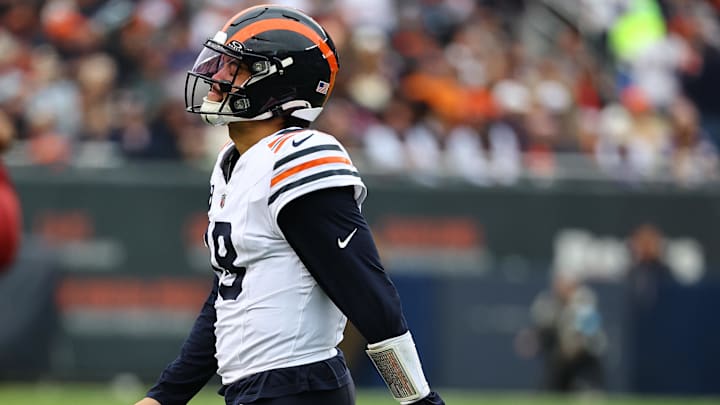The Chicago Bears were yet again edged out in a close game, falling to the Minnesota Vikings to the score of 30-27. An overtime thriller that featured dynamic performances from both offenses, Sunday's loss marks the fifth in a row for the Bears, who have to turn around quickly and face the Detroit Lions on Thanksgiving day.
Still, it's worth taking a closer look at the Bears' week 12 loss, and these four stats tell the story of how close the Bears were to snapping their losing streak:
340
Despite the loss, Caleb Williams had another great performance, finishing with an impressive 340 total passing yards.
The most any rookie has ever had against a Brian Flores-coached defense, Williams's passing total marked the second highest of his career, and his 373 total yards of offense on Sunday surpassed his previous best 368 total yard performance against the Indianapolis Colts.
WHAT A PLAY 🤯
— Chicago Bears (@ChicagoBears) November 24, 2024
📺: #MINvsCHI on FOX pic.twitter.com/TwqIJEneVJ
Even more impressive than Williams' totals was his performance in the clutch. Down 17 points, Williams finished the fourth quarter with 110 passing yards and two touchdowns while completing 12 out of his 16 attempts, including a clutch post-route connection to D.J. Moore that set up the game-tying field goal. Williams and the offense ultimately struggled in overtime, highlighted by a devastating sack on their only drive of the period, but the rookie's performance against Minnesota was a strong indicator of his potential going forward.
0
In a game that featured two outstanding offensive performances, it is important to note that Williams and Vikings quarterback Sam Darnold combined for 0 total interceptions.
Heading into the game, the Bears defense had forced a solid nine interceptions while the Vikings led the league with 16, but both of the former USC gunslingers were able to escape with a clean stat sheet.
.@CALEBcsw hits @Keenan13Allen to make it a one score game
— Chicago Bears (@ChicagoBears) November 24, 2024
📺: #MINvsCHI on FOX pic.twitter.com/KsBIGJ3d8h
Sunday marked Williams's fifth consecutive game devoid of an interception, while the game was just the fourth time this season the Bears defense has failed to pick off the opposing quarterback. Regarding the latter trend, it is also the third time in five games that the Bears have failed to get a turnover off the quarterback, a concerning trend for a defense that started the league as one of the stingier units in the NFL. In such a close, divisional contest, the Bears' offense would have benefited greatly if the defense could have turned Darnold over.
46.2%
The Vikings converted on third downs at an impressive 46.2% rate, which ultimately killed the Bears down the stretch.
Currently, the Detroit Lions convert at about a 46.8% rate, ranked third best in the NFL. The Bears allowed the Vikings, who average about 40% on the season, too many new sets of downs, and it ultimately became an insurmountable factor in the fourth quarter and overtime.
CLUTCH GENE ✅
— Minnesota Vikings (@Vikings) November 24, 2024
Sam Darnold x @TheeHOCK8
📺: @NFLonFOX pic.twitter.com/PdaxrPYldw
From the 4:20 mark in the third quarter on, the Bears failed to get a stop on third down, including a conversion on third and ten that ultimately led to the Vikings' game-winning field goal. Preventing long drives limits scoring opportunities for the opposition, but it also helps the offense build momentum instead of sitting on the sideline. If the Bears could have gotten off the field more on third down, they may have been able to walk away with the win.
3
As poorly as the defense played at times in the middle of the field, the Bears were stout in the redzone, allowing just 3 touchdowns.
Not including the Vikings' overtime drive in which they intentionally settled for a field goal, the visiting team had six red zone trips, and the Bears were able to successfully turn them away 50% of the time. The Bears are currently a top 5 red zone defense - allowing touchdowns on just 41% of such possessions - and Sunday was just another example of how this defense can bend but doesn't often break.
.@livinglegend_44 drops Darnold for a loss of 9
— Chicago Bears (@ChicagoBears) November 24, 2024
📺: #MINvsCHI on FOX pic.twitter.com/4i4mq6w2v2
Still, allowing six red zone possessions in regulation is quite a lot, and as great as it can be for momentum to turn your opponent away after a long drive, it would be even better to see more stops well outside of scoring range. The Bears will continue to be stingy in the red zone, but they will find more success if they can value the field position slightly more.
